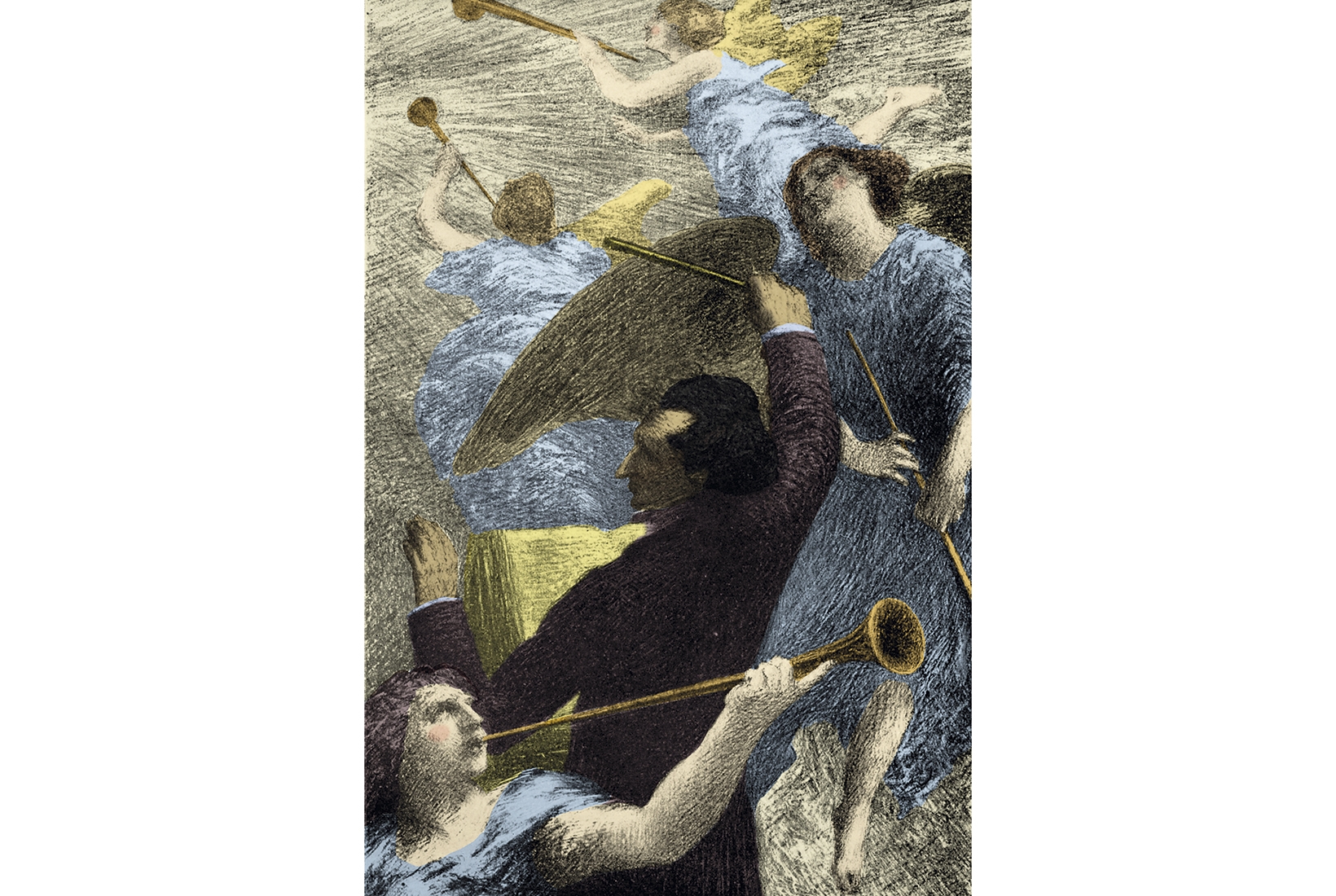At some point during the 20th century death disappeared. The dying were discreetly removed from our communities and homes, taken to hospitals with short memories and wipe-clean walls. Mourning blacks faded before vanishing altogether; the elaborate funeral monuments of the 19th century shrugged off curlicues and cherubs and arranged themselves into unobtrusive, apologetic sobriety. Coffins — gauchely literal — gave way to the more tasteful euphemism of the ash-filled urn. Only concert halls bucked the trend.
Suppressed from everyday life and language, death found a different outlet. How many choral societies or symphony choruses today go a year without performing a requiem mass? How often do Classic FM or Radio 3 go a day without playing music from one? It’s a rare Proms season that passes without a requiem or two, and every autumn around Remembrance Day concert halls and cathedrals across the country sell out performances of the Verdi, the Rutter or the Mozart. Even opera houses have begun to get in on the action.
In an increasingly secular society the persistence of requiems — musical settings of the Catholic mass for the dead — feels like a contradiction, an aberration. Artistic appeal easily accounts for the popularity of the historical settings, but not for the form’s vigorous ongoing life in the hands of today’s composers. Is it just cultural tourism or role-play, nostalgia for the rituals and consolations of a more spiritual age? Or is it a trace of something, a need that persists, but which we have silenced?
How we die reveals a lot about how we live. Death, and how we choose to commemorate it, exposes not just our fears and our faith (or the lack of it) but also our priorities, aspirations, what we value and what we disregard. In the 15th century they had a handbook for it, the Ars Moriendi — ‘The Art of Dying’. It was an instructional manual for a generation decimated by the Black Death, who knew that if disease or war didn’t come for them, then famine, childbirth or accident soon would. Average life expectancy was in the early thirties, so while people might hope for a long life, they planned for a ‘good death’.
The same need that prompted the Ars Moriendi and saw it printed well over 100 times before 1500, also fuelled the birth of the polyphonic requiem. Dating from some point after 1450, Flemish composer Johannes Ockeghem’s setting is the oldest surviving work of its kind — a requiem whose movements, though based closely on plainchant melodies, weave their own independent, multipart counterpoint.
Listen to its stark formality, to the roughly carved melodies, and you see the blank, angular faces of the painted martyrs of the same period. There’s nothing here of the grief, the anger, the terror of the settings we know and love, no clue to the private emotions of composer or victim. This is a public ritual — at least until the final movement, the offertory, where the ‘pains of hell’ suddenly rouse a lone bass into a passionate rhythmic frenzy, and all at once we’ve leapt across the centuries to Verdi and Berlioz and their blazing musical hell-fires.
String quartets are where composers whisper day-to-day truths, but the requiem is their confessional
The small but rich surviving repertoire of 15th- and early 16th-century requiems reveals something crucial to the genre. Although services commemorating the dead are recorded as early as 998 AD, the liturgy of the requiem mass was only formalised at the Council of Trent in the 1550s. The requiem was an official response to widespread demand for a rite that would both honour the dead and comfort the living. This organic, evolving form, sanctioned but not initially instigated by the Church, accounts for the patchwork nature of an unusual rite that is cobbled together from different pieces of liturgy, ranging widely in tone and vantage point. The result is a uniquely polyphonous text that speaks to the requiem’s origins in the community.
The requiem didn’t always exist; it was necessary to invent it. The requiem mass was born of human need, created to supplement a specific emotional and spiritual lack, and nowhere is this more evident than in Anglican works of the 20th century. The Book of Common Prayer contains no requiem mass, however composers including Britten and Herbert Howells found it necessary (just as Brahms had done earlier within a Lutheran tradition for his intensely personal German Requiem) to co-opt the form, to find ways of translating it for their own faiths and situations.
This is a model that is repeated again and again in the history of the requiem. Uniquely flexible, capable of expanding or contracting, incorporating additional sacred or secular text while still remaining recognisably itself, the form has had many faces. What other single genre could encompass pagan and Christian works, Verdi’s opera-in-disguise and Tomas Luis de Victoria’s starkly reverent setting, the searing political statement of Benjamin Britten’s War Requiem and the pastel prettiness of Fauré’s treatment? There are political requiems, requiems of protest and lament, personal musical tributes and dramatic fantasies of heaven and hell in which the sacred is less important than the sensational.
A requiem is a public performance of a private grief, the formalised and ritualised statement of the ineffable. It fulfils a role as much for the collective as the individual, artistically framing — taming even — the anarchic force that is death. Taking these musical works as social documents we can trace the shift from the 15th century to the 21st, from a world in which graveyards were at the centre of every village and town and death came as both judge and friend, through the soft-focus denial of the pious 19th century (whose graveyards have long since been banished beyond city limits) to the contradictory impulses of our own age, where death has become the ultimate taboo and music’s role and relationship to spirituality is constantly being tested and renegotiated.
While composers throughout history have tended to write multiple settings of the mass ordinary, the requiem mass is another matter. It is the exception to find multiple settings by a single composer, with only a handful of examples by major musicians — Victoria, most notably. It’s clear that this is a form that carries unusual weight, used for professional homages such as Verdi’s tribute-requiem for Rossini or Richafort’s for his revered colleague Josquin, or more intimately for the personal works of Howells, Fauré, Duruflé and Rutter that are dedicated to family members.
Yet whatever their outward focus, there’s always a strangely self-reflexive element to requiems. They are often late works, written when the composer’s mind is turning to his own death — a musical mirror held up to his own mortality. Robert Craft, Stravinsky’s long-time colleague and friend, wrote of the composer’s Requiem Canticles: ‘We knew he was writing it for himself,’ and it’s a pattern we see echoed again and again, perhaps most famously in Mozart. String quartets might traditionally be the diary for composers, the place of whispered day-to-day truths, but the requiem is their confessional.
Recommended recordings
Richafort’s Requiem, Huelgas Ensemble, Paul Van Nevel (Harmonia Mundi)
If there’s a more heart-stoppingly beautiful requiem than Richafort’s it’s hard to imagine. The mighty Huelgas basses anchor upper voices that seem suspended in the air in continuous, seamless musical arabesques — fan vaulting in sound.
Victoria’s Requiem, Gabrieli Consort, Paul McCreesh (DG Archiv)
Mourning the end not just of a life but of the Spanish Golden Age itself, Tomas Luis de Victoria’s 1605 requiem has a sober grandeur that McCreesh and his singers refuse to soften. Sternly lovely, this all-male account has an evocative, monastic edge to it.
Berlioz’s Grand Messe des Morts, Philharmonia Chorus & Orchestra, John Nelson (Erato)
Four hundred performers shake the pillars of St Paul’s Cathedral and set the dome ringing in this immense live recording which blazes with hell-fire and brimstone. Salvation may be the goal, but it’s the damnation that sticks.
Howells’s Requiem, Choir of St John’s College, Cambridge, Christopher Robinson (Naxos)
Like Brahms before him, Herbert Howells pieced together a highly personal requiem from textual fragments. The result is lyrical without being fey. Howells’s son Michael, who died age nine, is recalled poignantly here by the voices of Robinson’s boy trebles.
Stravinsky’s Requiem Canticles, SWR Baden-Baden, Michael Gielen (Hänssler)
Stravinsky’s last major work is a gnomic affair — a ritual to end a career of musical rituals. Caustic and self-consciously concise (the composer called it his ‘pocket requiem’), it’s a bracing corrective to too much wallowing, dispatched here with defiant, inscrutable clarity.







Comments